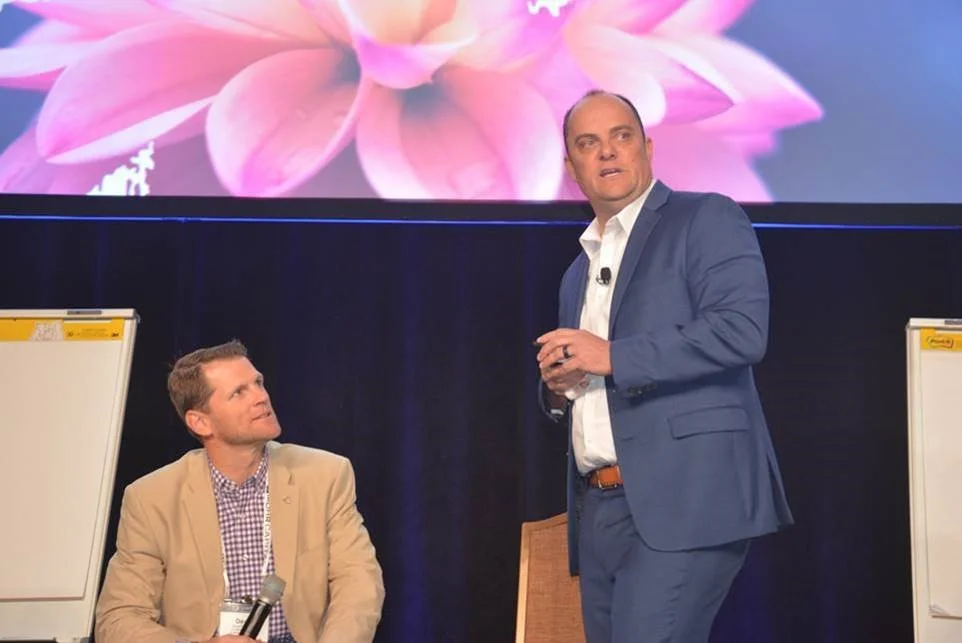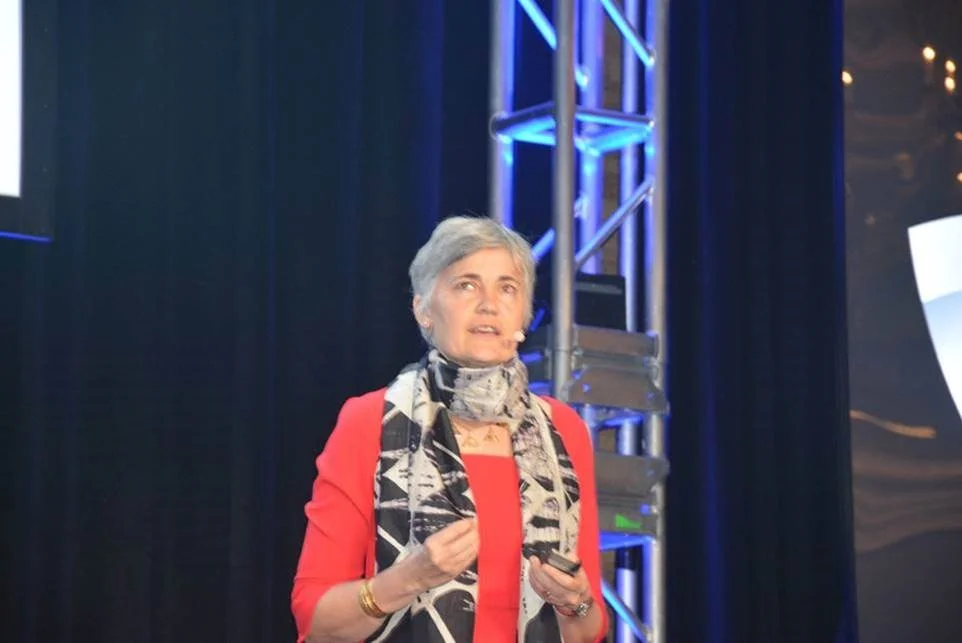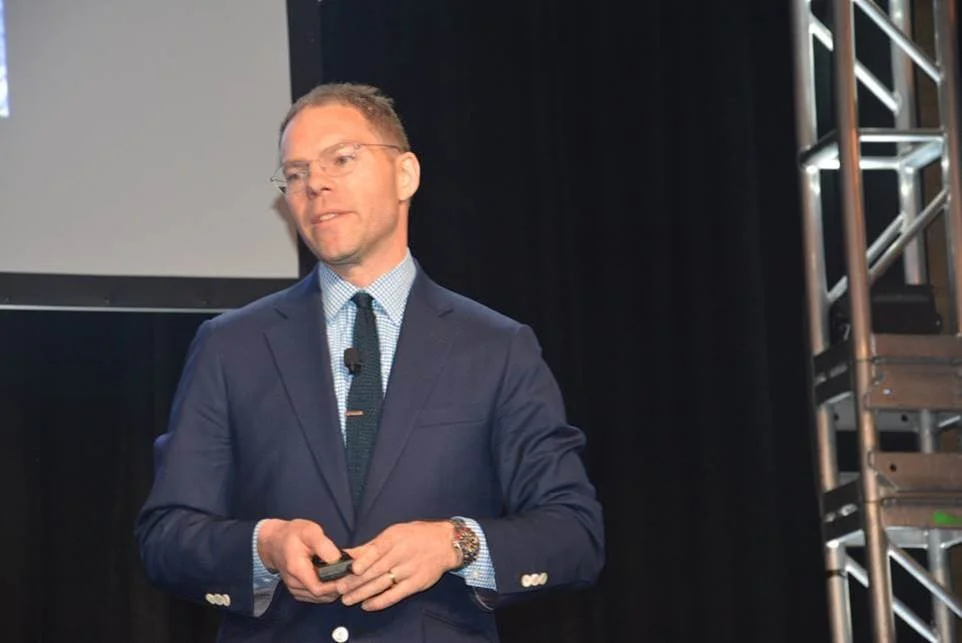SIOR DC Recap: Spring 2019 World Conference in the Nation’s Capital
Arlington House, which sits on a hill overlooking Arlington National Cemetery, offers views of the cemetery, the Washington Monument, Lincoln Memorial, the Potomac River and White House. A tour before the SIOR Spring World Conference is a humbling and inspiring way to kick off any conference in the Nation’s Capital.
The Spring SIOR World Conference in April had some of its strongest attendance in years (normally the fall conferences are busier), with nearly 1,000 SIORs, SIOR Associate Members, SIOR Member Associates and sponsors.
Key sponsors included Bank of America Merrill Lynch, Lincoln Property Trust, GLP, CenterPoint Properties, Becknell Industrial, Duke Realty, Rockefeller Group, CoStar Group, NAI Global and many others.

Simon Hartzell, Director of New Office Sales (on left) and Bruce Grant, Director of Sponsorships, managed the firm’s exhibitor booth at the SIOR Spring World Conference, held at the Omni Shoreham Hotel on Calvert Street. In addition to Simon and Bruce, the conference was attended by over a dozen of NAI Global’s SIORs.
The conference offered several keynote speaking addresses, breakout sessions to advance brokerage skills and plenty of networking.
Joseph Coughlin, Thursday Keynote Speaker
If Demography is Destiny, What is the Future of Real Estate?
Coughlin is Director of the Massachusetts Institute of Technology AgeLab.
He gave an engaging presentation in which he examined how the disruptive demographics of an aging society, social trends, and technology will shape future innovations.

Demography is destiny. Unlike economic and technology forecasting that are most often based upon selected and changeable assumptions, demographics are based upon the people that are already here. Demographic transition, evolving lifestyles as well as related technology trends are rapidly changing. These trends are likely to have a transformative impact on real estate touching residential and commercial property as well as fuel the growth of specialized emerging developments. Among these factors are the aging of the population, high divorce rates, smaller household composition, a three- or even four-generation workplace and the drastic reduction of fertility rates across the nation. This new demographic reality combined with the emergence of the sharing economy—a world where you can have it all, but own none of it—is changing our ideas about the future of community, home, retail and work.
Coughlin had some data with him – actually plenty of data.
By 2020, the 60+ global population will control 30 percent of global spending ($8 trillion a year).
To maintain the current population in the U.S., every woman would need to have 2.1 children – we are currently producing 1.9 children per woman. In Seoul, it’s 0.4 per woman of child bearing age.
By 2047, more people will be over the age of 60 than there will be children under 15. Japan is selling more adult diapers than the country is selling baby diapers. A Baby Boomer turns 74 every 7-8 seconds. The average American farmer is 61.
We’re delaying marriage, which delays household formations and having children. A high percentage of Americans between 18 and 34 are not even dating. 48 percent of Europeans under 34 are still living at home. We are increasingly living alone. 31 percent of Europeans are living solo – the same percentage in Japan, 27 percent of Americans are, and 15 percent of China’s adult population have gone solo.
We’re living to 100 and beyond and will do so even more in the future.

The author of The Longevity Economy said “the aging world is an opportunity more than a threat because it demands innovation.”
We’re living smaller too. After years of ever-increasing home sizes, home builders are building smaller homes, on average, as measured in square feet. We’re choosing “urbanesque” lifestyles, though not necessarily moving to big cities. There is a boom in college towns, because they have things to do, good healthcare systems and vibrant communities.
40 percent of Boomers are or are planning to work during classic retirement-age years – not for the money, but for the meaning. After all, the workplace is where we meet and maintain friendships, a workplace gives us our identities, connections and purpose.
Millennials want flexibility more than anything (68 percent, according to Coughlin’s research). They value autonomy in the workplace and expect a work/life balance. Millennials will have 5-8 careers in their lifetimes. They also prefer interaction and collaboration more than any generation.
“People are starting to live by subscription,” he said. More people are renting versus owning homes by choice. You can rent clothes (Rent the Runway) for a weekend or a month at a time. We’re giving up cars and taking a Zip car when we need one, riding a City Bike across town and dropping it off at a City Bike station, taking Uber or Lyft. We rent music on our phones instead of buying it.
Coughlin wrapped up by sharing Seven Possible Futures.
Commercial space becomes more important in recruiting and retaining employees in a tight and aging workforce market. Employers will seek urbanesque markets in second cities to meet converging Millennial and Baby Boomer desire for affordable living. Employers will seek high-intensity and amenity-rich experience centers to meet employees blurring work/life. A five generation workplace will demand multiple and highly flexible environments to accommodate diverse work/life and communication patterns. Smaller warehousing and logistics facilities closer to scattered activity centers will be required to support life by subscription and on-demand. Hyper-specialization of health services will demand more but smaller, clustered facilities beyond city centers. And lastly, entrepreneurship, gig workers will demand smaller “hive” work environments but in larger activity centers, such as hospitals, cities and biotech centers.

Gregg Brown, Principal with NAI Sioux Falls recently became an SIOR designee and attended his first SIOR conference. Ironically, Brown is from Washington, D.C. and started his real estate career in D.C. before moving to South Dakota years ago.
Emotional Intelligence and How to Be at Your Best More Often
Moving into the Thursday afternoon SIOR session in Washington, D.C., Catalyst 1 Global President and Management Consultant John Briggs gave a talk on Emotional Intelligence (EI), the science behind it and how it impacts performance in the workplace – especially at the leadership level.
“The art and science of leadership is what EI is all about and mastering it helps us be at our best more often,” said Briggs early in his presentation.

John Briggs’ work includes leading small and large teams for global, Fortune 100 corporations on enhancing C-Suite executives’ levels of emotional intelligence to be at their best more often. His extensive executive level development comes from years of training at Michigan’s Ross School of Business, Penn’s Wharton School of Business and the Harvard Kennedy School of Government.
What causes the difference in your personal performance during the best and worst moments of your life? More importantly, what outcomes were achieved as a result of both? Decades of clinical research suggest that these moments are a result of managing your emotional response, which have the greatest impact on your outcomes and relationships.
Briggs showed a slide with a photo and quote from Alvin Toffler, the American writer (Future Shock), futurist and businessman known for his works discussing modern technologies, to set up his opening monologue. “The illiterate of the 21st Century will not be those who cannot read and write, but those who cannot learn, unlearn, and relearn.”
We tend to get stuck in our own traditions and ways about learning, reacting and inter-acting, according to Briggs, and those things affect our emotional intelligence – which he pointed out is different from our feelings. Emotion drives behavior and feelings, he said.

After discussing the science that drives much of our emotional responses, Briggs secured a volunteer to demonstrate his points.
The science: the Limbic System (amygdala) is an almond-shaped set of neurons located deep in the brain’s media temporal lobe and shown to play a key role in processing emotions, including our fight or flight reaction to threatening situations; it drives cortisol surges, which Briggs likened to internally texting ourselves.
“If we act in these moments when there is not an actual threat – that is when we get in trouble,” he said. Cortisol surges function as an early warning system, he added.
Naturally occurring Serotonin, meanwhile, can overwhelm and break down excessive amounts of cortisol in our systems and create a calming effect. Serotonin is what allows us to think creatively and think in complexity – as opposed to those moments when we are charged by excessive cortisol, when we are incapable of thinking with reason.
The volunteer was naturally a little nervous when he first got on stage. Briggs used alternative thinking and breathing exercises to alter the cortisol surge the volunteer was feeling from anxiety and bring him back to a balanced emotional state. The alternative thinking method used was to count backward in sets of 3s to get to zero, beginning with 123. Then 120, 117, 114 etc. The need to concentrate reduces levels of cortisol, is the point. Generally speaking, it takes 18 minutes to calm down after threatening events cause cortisol surges in humans.

International SIORs and NAI Global professionals Bjarne Bauer, SIOR, and Managing Partner with NAI Sofia Group Shanghai, in China (left) and Valdis Ligers, Director Baltic Operations with NAI Baltics (serving Latvia, Estonia and Lithuania), along with Valdis’ wife, Ina Ligere, met in the Omni’s opulent central lobby for a quick chat.
Zipcar Co-Founder Robin Chase on the Sharing Economy and Transportation
On Friday Robin Chase, gave a talk on the sharing economy and drew examples from her expertise in transportation and what she learned by helping launch the innovative short-term car-sharing company based in Boston, Zipcar. Chase was also the former CEO of Zipcar.

“Because we work with a diversity of peers, the right person will appear,” is how Chase explained the fundamentals of a shared economy. She said we are in the midst of transitioning from an economy based on Industrial Capitalism to one based on collaboration that features “more networked minds,” “recognition of the benefits of shared and open assets” and the notion that if “you get one, you give one.”
Technology makes all this possible, of course, and Chase cited GPS systems, Internet, smart phones, electronic payments and other tools and apps. She said that 50 percent of future car trips will be made on or in micro-vehicles that will include scooters and e-scooters, showing data from recent pilot programs in Charlotte and Portland, OR.

Chase showed this slide in the context of her opinion that autonomous vehicles will make transportation even cheaper and amplify the underpinning problem of traffic, and the inherent inefficiency of congestion that prohibits movement and mobility. She encouraged more planning and for proof that good planning can generate positive results, she pointed to the High Line Park trail that meanders through blocks of Manhattan on the west side of 10th Avenue. Since the High Line opened, more than $1.5 trillion in real estate has been developed immediately adjacent to and near the elevated and linear pedestrian park.
The Future of Cities with Greg Linds
The final keynote speaker – the Saturday session sponsored by the SIOR Foundation, was Greg Lindsay. A journalist, urbanist and futurist, he is probably the smartest man in the room — for any room he enters. This statement is not made for excessive attitude – he seemed humble enough, but the guy did beat Watson in a competition and has won Jeopardy not once, but twice. In fact, he asked the audience near the end of his presentation that if we had questions for him, we should ask them in the form of answers. Lindsay joined NewCities Foundation in June 2015 as a Senior Fellow to lead its Connected Mobility Initiative. He is the author of Aerotropolis: The Way We’ll Live Next.

“Millennials will urbanize the suburbs,” said Lindsay at the start of his talk. He showed a slide from a single 2015 study by Ivanhoe Cambridge, a Canadian real estate company with assets around the globe, in which millennials (20-34 years of age) left large cities in droves that year. For New York-Newark-New Jersey, it was minus 42,625 net movers from/two different metropolitan areas; Los Angeles-Long Beach-Anaheim, 20,001; San Juan metro, Puerto Rico, 12,371; San Diego-Carlsbad, 11,808 and Chicago-Naperville, Elgin 11,356 (those were just the top five).
Why? Affordability is not as important as initially thought. What millennials want most is employment, lifestyle and accessibility – those matter more, he said.
Saying “things are going to get weirder before they get better,” Lindsay also talked about the work Walmart is doing to “reimagine its core business, which is highly ironic coming from the company that destroyed Main Street America and is now trying to reinvent it.”
Walmart, it turns out, like a whole lot of other retailers and businesses, is threatened by Amazon’s growth and tentacles in many lines of business that no one could have imagined possible even 10 years ago.
Other trends Lindsay mentioned included micro-housing, citing the Denver company, Zeppelin Development and its TAXI Campus that was stabilized in the city’s RiNo neighborhood last October and features over 100 low-income residents and more than 100 small businesses on a 24-acre site. He compared the project to residential trends that are occurring in Copenhagen. He also said that food courts are beginning to function as town halls and that “everyplace will be a coffee shop” as people increasingly demand more community space.

NAI KLNB’s Jim Caronna, SIOR, and a principal of the firm’s Baltimore office (left), visited with Jeremy Giles, Managing Director and Head of Global Customer Solutions in the Dallas office of Prologis.